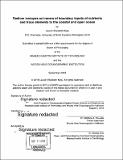Radium isotopes as tracers of boundary inputs of nutrients and trace elements to the coastal and open ocean
Author(s)
Kipp, Lauren Elizabeth
DownloadFull printable version (30.42Mb)
Other Contributors
Woods Hole Oceanographic Institution.
Advisor
Matthew A. Charette.
Terms of use
Metadata
Show full item recordAbstract
Nutrients and trace metals are vital for supporting life in the ocean, but the boundary processes that control the distributions of these elements are poorly constrained. Radium isotopes are well suited to studying inputs of elements from ocean margins because they are produced in sediments and soluble in seawater. The half-lives of the four isotopes (223Ra, 224Ra, 228Ra, 226Ra) range from days to thousands of years, thus these isotopes can be used to study oceanographic processes occurring over a range of time scales. In this thesis I have applied the quartet of radium isotopes to investigate boundary inputs, including seafloor hydrothermal vents, continental shelves, and rivers. First, radium isotope ratios were used to constrain the age of hydrothermal plumes emanating from vents along the Mid-Atlantic Ridge and East Pacific Rise. These radium-derived ages were applied to determine the iron residence time in the Pacific plume that emanates from near 15°S, providing an important constraint on the hydrothermal delivery of iron to the deep ocean. Next, 228Ra was used to show that shelf inputs to the Arctic Ocean have increased over the last decade, implying that the fluxes of other shelf-derived materials are also increasing and could impact primary production in this basin. The ratio of 228Ra and 226Ra was also applied to determine the ventilation time of Arctic intermediate waters with respect to shelf inputs, and the first measurements of 226Ra in the deep Canada Basin were used to estimate the residence time of deep waters with respect to benthic sediment inputs. Finally, a study of the Mackenzie River Estuary illustrated the importance of deltaic and estuarine processing on the ultimate delivery of nutrients, trace metals, dissolved organic matter, and radium to the Arctic Ocean. By applying radium isotopes as tracers of boundary inputs in these diverse environments, the work presented in this thesis improves our understanding of nutrient and trace metal inputs to the coastal and open ocean.
Description
Thesis: Ph. D., Joint Program in Oceanography/Applied Ocean Science and Engineering (Massachusetts Institute of Technology, Department of Earth, Atmospheric, and Planetary Sciences; and the Woods Hole Oceanographic Institution), 2018. Cataloged from PDF version of thesis. Includes bibliographical references.
Date issued
2018Department
Joint Program in Oceanography/Applied Ocean Science and Engineering; Woods Hole Oceanographic Institution; Massachusetts Institute of Technology. Department of Earth, Atmospheric, and Planetary SciencesPublisher
Massachusetts Institute of Technology
Keywords
Joint Program in Oceanography/Applied Ocean Science and Engineering., Earth, Atmospheric, and Planetary Sciences., Woods Hole Oceanographic Institution.